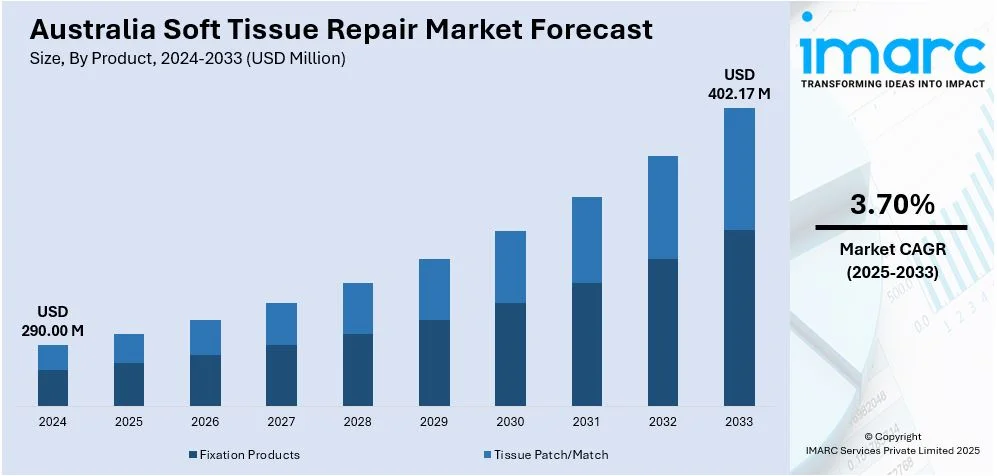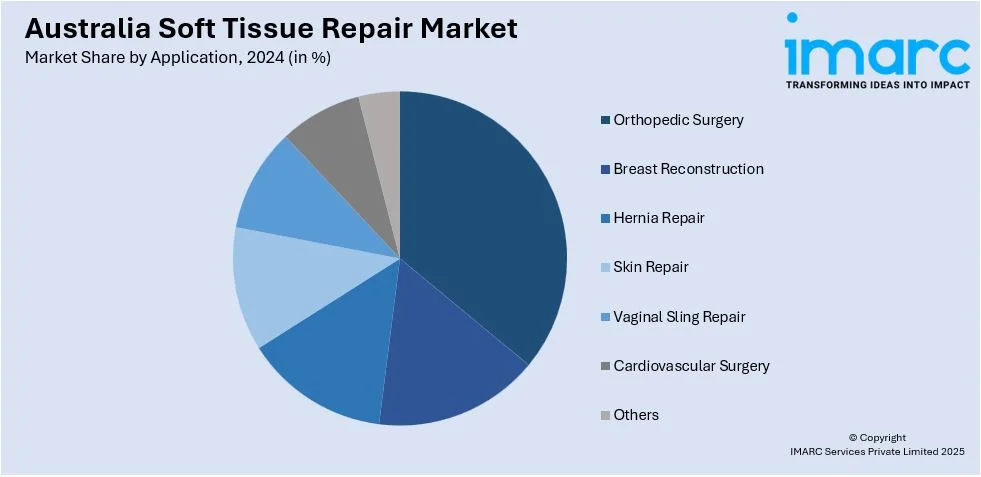
Australia Soft Tissue Repair Market Size, Share, Trends and Forecast by Product, Application, End Use, and Region, 2025-2033
Australia Soft Tissue Repair Market Overview:
The Australia soft tissue repair market size reached USD 290.00 Million in 2024. Looking forward, IMARC Group expects the market to reach USD 402.17 Million by 2033, exhibiting a growth rate (CAGR) of 3.70% during 2025-2033. The market is driven by rising sports-related injuries, growing elderly population with degenerative disorders, expanding adoption of biologics and regenerative therapies, increasing incidence of trauma and orthopedic surgeries, and technological advancements in surgical tools and grafts supporting faster and more effective tissue regeneration procedures across hospitals and ambulatory settings.
|
Report Attribute
|
Key Statistics
|
|---|---|
|
Base Year
|
2024 |
|
Forecast Years
|
2025-2033
|
|
Historical Years
|
2019-2024
|
| Market Size in 2024 | USD 290.00 Million |
| Market Forecast in 2033 | USD 402.17 Million |
| Market Growth Rate 2025-2033 | 3.70% |
Australia Soft Tissue Repair Market Trends:
Integration of Bioengineered Scaffolds in Surgical Repairs
In Australia, soft tissue repair is increasingly using bioengineered scaffolds, especially for tendon and ligament procedures. These scaffolds replicate the extracellular matrix, supporting cell growth and tissue repair. Their biodegradable nature and low rejection risk make them suitable for complex cases. Hospitals and researchers are working with biomaterials developers to expand clinical use. Trials show faster recovery and better healing. Surgeons now prefer these regenerative options over traditional implants, encouraged by strong clinical evidence and continuous progress in biomaterial technologies. For instance, in March 2025, Aroa Biosurgery, a New Zealand-based regenerative medicine company, announced that it had surpassed seven million uses of its sheep-derived soft-tissue repair products globally. Its extracellular matrix (ECM) technology, sourced from the ovine forestomach, supports healing in complex wounds. Key products like Endoform, OviTex, Myriad, and Symphony have received FDA clearance and are used across 50+ countries. Ongoing clinical trials, including for diabetic foot ulcers, aim to strengthen product adoption. Aroa is expanding globally and developing innovative platforms like Enivo for managing post-surgical tissue cavities.

To get more information on this market, Request Sample
Rising Demand for Minimally Invasive Procedures
Minimally invasive soft tissue repair procedures are gaining traction across Australia due to reduced recovery times, less postoperative pain, and shorter hospital stays. For instance, as per industry reports, Australia’s minimally invasive surgery market is projected to generate revenue of USD 1,156.8 Million by 2028. Arthroscopic and laparoscopic techniques are being increasingly employed for rotator cuff, anterior cruciate ligament (ACL), and hernia repairs. Surgeons are leveraging enhanced imaging systems and robotic assistance to achieve greater precision, particularly in anatomically sensitive areas. The shift is further supported by insurance providers and health systems seeking cost efficiencies. Patient preference for outpatient settings and the growing availability of specialized day-surgery centers have also reinforced this trend. As minimally invasive technologies continue to advance, their application is expected to grow across both trauma and sports injury segments.
Australia Soft Tissue Repair Market Segmentation:
IMARC Group provides an analysis of the key trends in each segment of the market, along with forecasts at the region/country level for 2025-2033. Our report has categorized the market based on product, application, and end use.
Product Insights:
- Fixation Products
- Suture
- Suture Anchors
- Tissue Patch/Match
- Biological
- Synthetic
The report has provided a detailed breakup and analysis of the market based on the product. This includes fixation products (suture and suture anchors) and tissue patch/match (biological and synthetic).
Application Insights:

- Orthopedic Surgery
- Breast Reconstruction
- Hernia Repair
- Skin Repair
- Vaginal Sling Repair
- Cardiovascular Surgery
- Others
The report has provided a detailed breakup and analysis of the market based on the application. This includes orthopedic surgery, breast reconstruction, hernia repair, skin repair, vaginal sling repair, cardiovascular surgery, and others.
End Use Insights:
- Hospitals and Clinics
- Research and Academic Institutes
- Others
The report has provided a detailed breakup and analysis of the market based on the end use. This includes hospitals and clinics, research and academic institutes, and others.
Regional Insights:
- Australia Capital Territory & New South Wales
- Victoria & Tasmania
- Queensland
- Northern Territory & Southern Australia
- Western Australia
The report has also provided a comprehensive analysis of all the major regional markets, which include Australia Capital Territory & New South Wales, Victoria & Tasmania, Queensland, Northern Territory & Southern Australia, and Western Australia.
Competitive Landscape:
The market research report has also provided a comprehensive analysis of the competitive landscape. Competitive analysis such as market structure, key player positioning, top winning strategies, competitive dashboard, and company evaluation quadrant has been covered in the report. Also, detailed profiles of all major companies have been provided.
Australia Soft Tissue Repair Market News:
- In February 2025, Tissue Repair Ltd advanced its wound healing portfolio with TR987, a proprietary treatment now in phase three trials in Australia and the US, targeting chronic venous leg ulcers. The company also launched TR Pro+, a post-procedure topical treatment, now used in 300 clinics with 10% monthly sales growth. Tissue Repair is finalizing Australian distribution deals and pursuing global expansion, ensuring diversified growth through both clinical innovation and commercial success.
- In December 2024, Kerecis launched SurgiClose® Silicone, a new product combining intact fish-skin grafts with a silicone contact layer for treating surgical and trauma wounds. The innovation streamlines surgical workflows by eliminating the need for separate contact layers, enhancing efficiency and cost-effectiveness. Available in adhesive and standard forms, it expands Kerecis’s SurgiClose® line, which uses sustainably sourced fish skin for soft-tissue repair. This development supports Kerecis’s ongoing mission to provide advanced, biologically integrated wound care solutions with proven clinical and economic benefits.
- In August 2024, Aroa Biosurgery expanded clinical validation for its extracellular matrix (ECM) soft tissue repair products, including Myriad and Symphony. The Myriad Registry showed promise in trauma and limb salvage procedures. Symphony, combining ECM and hyaluronic acid, is under trial for diabetic ulcers.
Australia Soft Tissue Repair Market Report Coverage:
| Report Features | Details |
|---|---|
| Base Year of the Analysis | 2024 |
| Historical Period | 2019-2024 |
| Forecast Period | 2025-2033 |
| Units | Million USD |
| Scope of the Report |
Exploration of Historical Trends and Market Outlook, Industry Catalysts and Challenges, Segment-Wise Historical and Future Market Assessment:
|
| Products Covered |
|
| Applications Covered | Orthopedic Surgery, Breast Reconstruction, Hernia Repair, Skin Repair, Vaginal Sling Repair, Cardiovascular Surgery, Others |
| End Uses Covered | Hospitals and Clinics, Research and Academic Institutes, Others |
| Regions Covered | Australia Capital Territory & New South Wales, Victoria & Tasmania, Queensland, Northern Territory & Southern Australia, Western Australia |
| Customization Scope | 10% Free Customization |
| Post-Sale Analyst Support | 10-12 Weeks |
| Delivery Format | PDF and Excel through Email (We can also provide the editable version of the report in PPT/Word format on special request) |
Key Questions Answered in This Report:
- How has the Australia soft tissue repair market performed so far and how will it perform in the coming years?
- What is the breakup of the Australia soft tissue repair market on the basis of product?
- What is the breakup of the Australia soft tissue repair market on the basis of application?
- What is the breakup of the Australia soft tissue repair market on the basis of end use?
- What is the breakup of the Australia soft tissue repair market on the basis of region?
- What are the various stages in the value chain of the Australia soft tissue repair market?
- What are the key driving factors and challenges in the Australia soft tissue repair market?
- What is the structure of the Australia soft tissue repair market and who are the key players?
- What is the degree of competition in the Australia soft tissue repair market?
Key Benefits for Stakeholders:
- IMARC’s industry report offers a comprehensive quantitative analysis of various market segments, historical and current market trends, market forecasts, and dynamics of the Australia soft tissue repair market from 2019-2033.
- The research report provides the latest information on the market drivers, challenges, and opportunities in the Australia soft tissue repair market.
- Porter's five forces analysis assist stakeholders in assessing the impact of new entrants, competitive rivalry, supplier power, buyer power, and the threat of substitution. It helps stakeholders to analyze the level of competition within the Australia soft tissue repair industry and its attractiveness.
- Competitive landscape allows stakeholders to understand their competitive environment and provides an insight into the current positions of key players in the market.
Need more help?
- Speak to our experienced analysts for insights on the current market scenarios.
- Include additional segments and countries to customize the report as per your requirement.
- Gain an unparalleled competitive advantage in your domain by understanding how to utilize the report and positively impacting your operations and revenue.
- For further assistance, please connect with our analysts.
 Request Customization
Request Customization
 Speak to an Analyst
Speak to an Analyst
 Request Brochure
Request Brochure
 Inquire Before Buying
Inquire Before Buying




.webp)




.webp)












